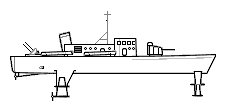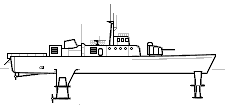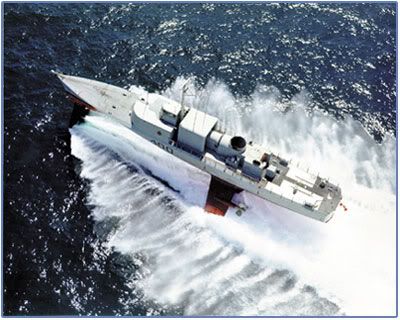[size=5]Il Mundo 1930/1931[/size]
Orders from the Regia Marina and other countries, notably Argentina and the Philippines have ensured that the shipbuilding sector and the economy overall has continued to grow smoothly. Notable exports were the two cruisers for Argentina that have spent the last 3 years building in CRDA Trieste, and the Ariete class of torpedo boats which have proven popular with overseas customers. A total of 20 examples have been purchased by the Philippines, Yugoslavia and Persia, with 8 delivered so far. Two esploratori have also been ordered by Argentina as they continue to retire older warships.
New ships ordered by the Regia Marina this year include 3 Armoured Cruisers, 6 destroyers and 8 coastal submarines. The cruisers will serve to augment the already powerful Zara class. Upon their completion, the cruiser
Regina Elana will recommission as a training vessel. The coastal submarines are in many ways reduced versions of the Da Vinci and Brin classes and are more suited to Mediterranean operations due to their smaller size.
The 6 destroyers ordered, so called “Soldati” due their naming after military units will complete in November and enter service in May of 1932. They are an extension of the prototype
Baleno, but to a modified, more conservative design after problems with her were encountered. The Soldati Class have 1.00m more beam and a more compact superstructure.
The roles of the destroyer are;
- Protect against torpedo attack from torpedo boats and other destroyers
- Protect against submarines
- Ability to act offensively with torpedoes
- Protection against aircraft
The Soldati class present a more balanced design that fulfills all these requirements whilst still retaining their small size of 1600tons. 1. The 4x130mm guns forward provide excellent arcs of fire against destroyers, with the 36kg SAP shell being especially hard-hitting, 2. Supermarina has announced that the class feature considerable improvements to combat submarines, 3. The slow speed of 32knts that this class was forced to accept was due to needs elsewhere being more pressing. The speed would have limited their usefulness had not they been fitted with the larger 600mm torpedo which allows them to engage at a longer range, 4. The anti-aircraft suite is thought to be good considering the size of ship, with 8x37mm guns and 2x25mm guns being included. Other things to note are the small stabilisers included in the bilges which hope to reduce pitch and roll.
Trials with the experimental Aliscafo program continued throughout 1930 with mixed results. The small vessel, Hydro-Aerei 1, of 75tons and fitted with petrol engines has been found to give good performance in light seas in il Golfo di Taranto. The normal drive used to power 2 propellers gave a maximum speed of approximately 40knts. An interesting comparison, is with the similar sized MAS1000 series which need twice as much power to attain a similar speed. However a large problem was found when encountering following seas, i.e. when the vessel is proceeding in the same direction as the waves. H-A 1 came off the foils and exhibited a sea crash on numerous occasions when trying to plane over waves of state 2/3. Eventually some damage was caused, giving rise to the vessel being sent back to Baglietto for repairs.


In addition to small 75ton craft, H.A. 1, two larger craft were ordered in January 1930 with the view to producing a vessel with better seakeeping ability. The two vessels, AS.1 and AS.2 were ordered from Fincantineri in Venice and weighed about 200tons. The foil arrangement differed from HA.1 with the rear foil taking most of the lift and the smaller forward foil responsible for lifting the nose of the craft over waves. The power was provided from lightweight steam turbines which produced 10,000shp. During trials throughout 1930 these were found to be far too delicate and unreliable, the crews being more used to petrol-powered aero engines. Unfortunately, as a result of this, the Captain was loathe to perform trials in heavy seas, so experience was limited to daylight fair-weather operations. Even with this constraint the turbines proved too unreliable. There were limited weapons testing, gunnery trials proved successful but launching torpedoes presented unseen difficulties. 4X533mm mounts were used from the MAS1000 class with compressed air used to eject the torpedo from the tube. The location of the tubes caused the torpedoes to sometimes contact the foils if launched on the upside of a wave. The additional problem was that the speed of the vessel was about the same as the torpedo. As a result both vessels were taken back to Fincantieri to have new engines fitted. AS.1 received Isotta-Fraschini Asso 1000 petrol engines, 8 geared to 2 shafts with a Z drive giving 16000shp in total, weight is about 11tons. AS.2 received new Guidoni type Diesel engines, 4 geared to 2 shafts giving 16.000shp weighing about 25tons. These new engines have been much more successful and reliable. Tests in March gave good results with a maximum speed of 54knts being recorded. Results of rough weather trials in state 5/6 have not been sorted but are generally perceived to be excellent. RN
Ottoviano Augusto a 3,000-ton cruiser sailing in company during a rough water trial sent a signal as follows: "Weather conditions were considered most unpleasant, heavy seas and 5-7 m swell, wind gusting to 60 knots, ship spraying overall with upper deck (of
Augusto) out of bounds most of the time. AS.2 appeared to possess enviable seakeeping qualities. She was remarkably stable with a noticeable absence of roll and pitch, and apparently no lack of maneuverability. The almost complete absence of spray over the fo'c's'le and bridge was very impressive." Trials with the new motors continue and it is undecided which shall be chosen for production but the lighter weight petrol engines give more room available for weapons.



From top,
AS.1 original configuration, AS.2 as refitted, note moving of TT, AS.2 foilborne in il Golfo di Taranto
This article appeared in the last report.
The aircraft-carrying submarine
Ettore Fieramosca has had some slight modifications over the past month. A small catapult was installed on her foredeck and she loaded small aircraft onboard in Taranto on numerous occasions. She was never seen to be unloading aircraft. It is presumed that they landed onshore. Fishing vessels in the area reported seeing small aircraft behaving erratically in the Golfo di Taranto. It is possible that the aircraft, of unknown type is suffering from some problems. The most likely case is that a few one-off aircraft have been built especially for
Fieramosca and some corners have been cut for small size.
Now this photograph taken can be displayed alongside.







